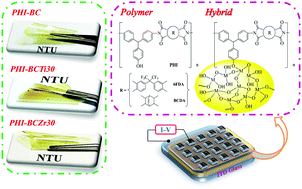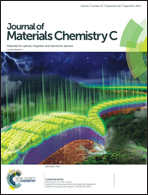Highly transparent polyhydroxyimide/TiO2 and ZrO2 hybrid films with high glass transition temperature (Tg) and low coefficient of thermal expansion (CTE) for optoelectronic application†
Abstract
A novel polyhydroxyimide and the respective polymer hybrids of titania or zirconia with remarkable thermal stability and optical properties have been successfully prepared. Polyhydroxyimides (PHIs) with high transparency were synthesized through one-step polycondensation. The hydroxyl groups in the repeating units of polymer backbone contribute organic–inorganic bonding reaction sites for preparing homogeneous films of hybrids. The hybrids displayed low coefficient of thermal expansion (CTE) (23 ppm °C−1 for PHI-BCZr30) and extraordinary thermal stability essential to sustain high glass transition temperatures (Tg) (350–410 °C). The transparency of thin film based on PHI-BC reaches 96% at 400 nm, and the refractive index of PHI-6F reaches 1.63. In addition, these polymer films of the hybrids revealed tunable refractive index (1.63–1.84 for PHI-6F/TiO2 and 1.63–1.81 for PHI-6F/ZrO2), and the hybrid films of PHI-BC/ZrO2 exhibited higher Abbe′s number and optical transparency than those of PHI-BC/titania system because of a larger band gap of zirconia. On introducing titania and zirconia, as electron acceptors, into PHI-6F, the charge-transfer complex could be facilitated and stabilized owing to the lower LUMO energy level of the resulting materials of the hybrid. Consequently, the memory devices fabricated from the polymer hybrid films manifested tunable memory properties from SRAM, and DRAM, to WORM at various titania or zirconia contents from 0 to 50 wt% with a high ON/OFF ratio (108). Moreover, various energy levels of titania and zirconia demonstrated the uniquely distinct memory characteristics, indicating that the PHIs/TiO2 and PHIs/ZrO2 hybrid films, as memory devices with high transparency, have strong potential in electrical applications.



 Please wait while we load your content...
Please wait while we load your content...